September’s rain has done a tremendous favor for our fall kaleidoscope of butterflies. It’s created a burst of blooms in our native plant communities. More blooms, more butterflies.
If you haven’t given this a thought, the opposite is true in drought years. No rain, no blooms, — butterflies go elsewhere to seek nectar in order to survive.
October is the time of year I gently urge you to get out of the house, jump in your car and go directly to the nearest nursery or native plant grower and buy plants that are in bloom.
You can find local native plant growers here: https://rgvctmn.org/rgv-plants/.
You don’t even have to plant the plants — just bunch them all together somewhere in your yard, porch or patio, or line them up alongside your driveway. Do water the plants so they continue to bloom.
However, it you want to keep resident butterflies through the winter, plant your purchases.
According to a wonderful pdf by our local butterfly center in Mission, there are different strengths of nectar. They’ve listed many of our native plants in a useful spreadsheet that you can download. Here’s the link: https://naba.org/chapters/nabast/plants_info.pdf.
Special October Event Opportunity: If you want to know more about nectar plants or plants that attract butterflies, South Padre Island’s Native Plant Center is the place to be October 27 — the last Saturday prior to Hallowe’en.
I will be giving two presentations during the Native Plant Center’s and SPI Birding & Nature Center’s joint annual Hallo-Wings event celebrating butterflies. Numerous activities and presentations are scheduled — think fun as well as advanced training or continuing education points.
At 10 a.m. my presentation at the Native Plant Center will be on the Wonderful World of Nectar and at 2 p.m., The Doable Dozen — Host Plants for Butterflies.
Check out this link for specifics and location address:
Getting back to your “shop now for blooming plants” shopping spree, here’s some information to help you choose the best sources of nectar listed in the NABA spreadsheet.
Nectar categories:
Excellent
Very good
Good
Fair
Excellent nectar rated plants:
In the excellent nectar category, consider purple fall-blooming mistflower, (Chromolaena odorata), also called crucita.
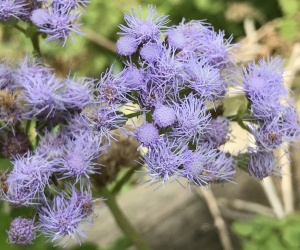
When I give presentations about butterflies, I always tell the audience, if you have room for only one plant, make it Crucita — fall-blooming purple mistflower.
One of the nature educators at McAllen’s Quinta Mazatlán watched a stand of Crucita one fall afternoon a few years ago. The small bush was absolutely aflutter with butterflies. She counted no less than 20 different species drawing nectar from the flowers.
Crucita is one of my favorite fall flowers for other reasons. It easily self-propagates. Actually, it easily — and abundantly –self-propagates! It also transplants easily and successfully, which will make you popular when you share it with your friends come spring. In the spring, although it’s fall-blooming, it can be encouraged to bloom if you water it a couple times a week. After those blooms are spent, trim the shrub back to about 18 inches and then wait for the real bloom-show beginning in October, when it is really worth its weight in nectar-gold.
Here are some visitors to mine the first two weeks of October:
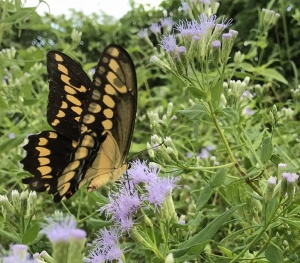
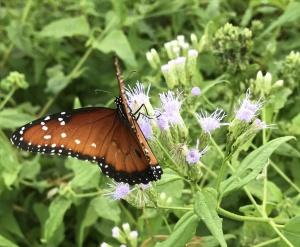
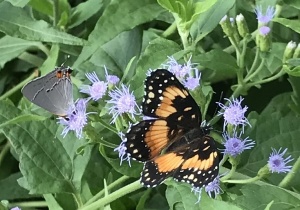

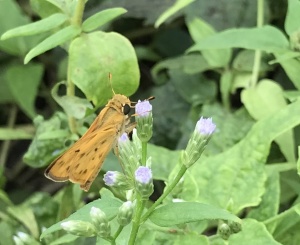
Three Valley sun-loving lantanas are all in the excellent nectar category. Take your pick or buy them all for a rainbow of butterfly activity: Texas lantana (Lantana urticoides); West Indian lantana (Lantana camara); and velvet lantana (Lantana velutina).

Choose your color scheme — red and yellow-blooming Texas lantana planted adjacent to purple crucita can give your garden a pretty dramatic fall ambiance — tuck a pumpkin or two peeking out from under the spread of these two low-growing shrubs, add a couple of witches, maybe a black cat, bats, fruit of the wild olive for eye of newt — or leave the plants in their original floral costume — the butterflies will flock to the blooms.
Yellow-and-pink-blooming lantana camara goes equally well with crucita, which offers a more pastoral vibe to your landscape.
Texas lantana may grow to heights of 18 to 24 inches with a five-foot spread. West Indian lantana is a more upright bush-shape about 3 ½ feet tall. Velvet lantana can reach that height as well, in a dense, more compact shrubby shape. Velvet lantana can keep blooming into December.
Birds are our friends with lantana. They’ll eat the fruit and help with propagation.
If you have only room for one small tree, make it the wild olive (Cordia boissieri). A native, this tree is well worth planting. First of all, it blooms all year which makes it a continuing, excellent source of nectar. It attracts butterflies, hummingbirds and beneficial pollinators. One caution, the tree produces one-inch long, oblong, white, fleshy, gelatinous fruits that fall to the ground. When wet, they are tremendously slick. Don’t plant a wild olive near walkways or driveways. But plant it close enough where you can watch the activity that will come to your wild olive all year long.

Very good nectar rated plants:
Two red-blooming plants in the very good category are scarlet sage (Salvia coccinea) and Turk’s cap (Malvaviscus drummondii). Plant in full sun. These two plants will bloom through December attracting multiple species of butterflies — as a bonus, you’ll probably attract hummingbirds, too!
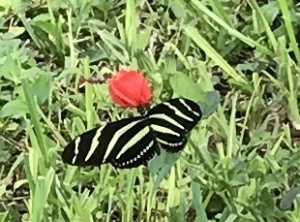
All you need is one scarlet sage plant this fall — to have a bounty of them in the spring. It’s extremely self-propagating, more prolific than rabbits. But get a half dozen plants, now — more blooms, more butterfly food! Usually these plants are about one to two feet tall. You might get a mustang plant that will gallop up to about three feet or taller. When your patch of scarlet sage gets unsightly or leggy, whack it off with a weed-eater (or more politely, with hand clippers) and wait for it to come up again. Once the root base of scarlet sage is established, you’ll keep a good stock of the plant — probably forever. But that’s a good thing!
Turk’s cap also is happy in partial shade — like around the base of a mesquite tree. This is a fun plant to put where you can quietly observe the activity it brings to your garden. You’ll maybe even see a great kiskadee hop up and pluck a round white fruit from the plant. Turk’s cap, especially in shaded areas, tends to travel up the branches seeking sunlight, but that doesn’t stop it from blooming profusely.
Another very good nectar plant is a small shrub with white blooms: heliotrope (Heliotropium angiospermum). It’s an all-time favorite, drawing a rabble of small butterflies. On a sunny day, heliotrope, also called scorpion’s tail, will be busy with white peacock butterflies as well as pretty little yellow sulphurs, duskywings, metalmarks, checkerspots and blues. Heliotrope blooms in all seasons — butterfly food all year long! The shrub forms a nice shape, and has attractive dark green, textured leaves.

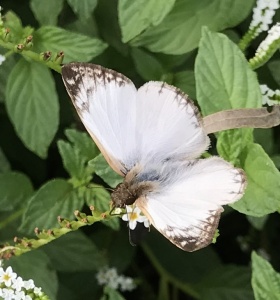

Heliotrope is another native plant that, if you have one, you’ll have a good stock of them in subsequent years. Learn to recognize their distinctive leaves in the spring when they are just pushing up out of the ground. Great time to pot up and share the plant or keep them where they appear — more butterflies for you!
If you follow my blog, you’ll know I love using collective nouns. I’ve used several collective nouns for butterflies in this post: kaleidoscope, rainbow, rabble and flutter.
Beautiful article and pictures and thanks so much for the link to the comprehensive list of plants for both hosts and nectar. I’m disappointed to have to miss the presentation on the 27th because of the Laguna clean-up previously agreed to. I do wish October wasn’t such a great month for everything.
Thank you, Frances. Hopefully I’ll give the presentation elsewhere. I’ll be sure to let you know! I agree about the month of October, especially when one wants to do absolutely everything there is to do!
Your blog was amazing. I have no idea how all those descriptive words just pop up in your head…but I’m so glad they do. This article put me right in the midst of the garden as though I was actually seeing them in person. Thanks for your time and gift of writing.
Thank you for your kind words, Tina. I’m a logophile. I’ve been collecting fun words all my life. Some fun things to Google are: Collective venery nouns or collective bird nouns. Another fun thing to look up on Google is Vivid Verbs. A wee caution though, once you start looking up descriptive words, it becomes rather addictive.